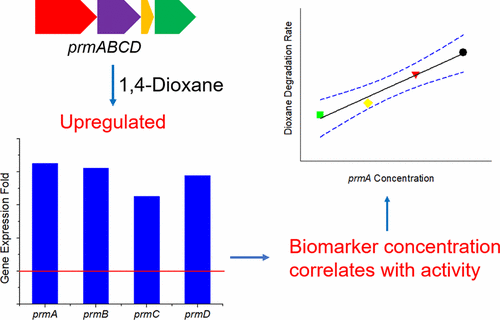当前位置:
X-MOL 学术
›
Environ. Sci. Technol. Lett.
›
论文详情
Our official English website, www.x-mol.net, welcomes your
feedback! (Note: you will need to create a separate account there.)
1,4-Dioxane Biodegradation by Mycobacterium dioxanotrophicus PH-06 Is Associated with a Group-6 Soluble Di-Iron Monooxygenase
Environmental Science & Technology Letters ( IF 8.9 ) Pub Date : 2017-11-01 00:00:00 , DOI: 10.1021/acs.estlett.7b00456 Ya He 1 , Jacques Mathieu 1 , Yu Yang 1 , Pingfeng Yu 1 , Marcio L. B. da Silva 1 , Pedro J. J. Alvarez 1
Environmental Science & Technology Letters ( IF 8.9 ) Pub Date : 2017-11-01 00:00:00 , DOI: 10.1021/acs.estlett.7b00456 Ya He 1 , Jacques Mathieu 1 , Yu Yang 1 , Pingfeng Yu 1 , Marcio L. B. da Silva 1 , Pedro J. J. Alvarez 1
Affiliation

|
1,4-Dioxane (dioxane) is a groundwater contaminant of emerging concern for which bioremediation may be a promising strategy. Several bacterial strains can metabolize dioxane or degrade it cometabolically. However, the molecular basis of dioxane biodegradation is only partially understood, and the gene coding for dioxane/tetrahydrofuran (THF) monooxygenase in Pseudonocardia dioxanivorans CB1190 is the only well-characterized catabolic gene. Here, we identify a novel group-6 propane monooxygenase gene cluster (prmABCD) in Mycobacterium dioxanotrophicus PH-06, which is a bacterium with superior dioxane degradation kinetics compared with CB1190. Whole genome sequencing of PH-06 revealed the existence of a single soluble di-iron monooxygenase (SDIMO). RNA sequencing and reverse transcription quantitative PCR (RT-qPCR) subsequently confirmed that all four components of this gene cluster are upregulated when PH-06 is grown on dioxane compared with growth on acetate or glucose as negative controls. This first characterization of a group-6 SDIMO associated with dioxane biodegradation suggests that dioxane-degrading genes may be more diverse than previously appreciated. A primer/probe set designed to target the large hydroxylase subunit of this gene cluster exhibited high selectivity (no false positives) and high sensitivity (detection limit = 3000–4000 gene copies/mL culture), which may be useful to help assess the presence of dioxane degraders at contaminated sites and minimize false negatives.
中文翻译:

分枝杆菌二氧氮营养菌PH-06对1,4-二氧六环的生物降解作用与第6组可溶性二铁单加氧酶相关
1,4-二恶烷(dioxane)是引起人们关注的地下水污染物,对其进行生物修复可能是一种有前途的策略。几种细菌菌株可以代谢二恶烷或将其代谢分解。但是,对二恶烷生物降解的分子基础仅是部分了解,并且假恶心假二恶草腈CB1190中编码二恶烷/四氢呋喃(THF)单加氧酶的基因是唯一特征明确的分解代谢基因。在这里,我们确定了一个新的第6组丙烷单加氧酶基因簇(prmABCD)在分枝杆菌二氧氮营养菌中PH-06是一种比CB1190具有更好的二恶烷降解动力学的细菌。PH-06的全基因组测序表明存在单个可溶性二铁单加氧酶(SDIMO)。RNA测序和逆转录定量PCR(RT-qPCR)随后证实,当PH-06在二恶烷上生长时,与醋酸盐或葡萄糖作为阴性对照相比,该基因簇的所有四个成分均被上调。与二恶烷生物降解有关的第6组SDIMO的第一个特征表明,降解二恶烷的基因可能比以前认为的更为多样化。针对该基因簇的大型羟化酶亚基设计的引物/探针组显示出高选择性(无假阳性)和高灵敏度(检测极限= 3000–4000基因拷贝/ mL培养物),
更新日期:2017-11-02
中文翻译:

分枝杆菌二氧氮营养菌PH-06对1,4-二氧六环的生物降解作用与第6组可溶性二铁单加氧酶相关
1,4-二恶烷(dioxane)是引起人们关注的地下水污染物,对其进行生物修复可能是一种有前途的策略。几种细菌菌株可以代谢二恶烷或将其代谢分解。但是,对二恶烷生物降解的分子基础仅是部分了解,并且假恶心假二恶草腈CB1190中编码二恶烷/四氢呋喃(THF)单加氧酶的基因是唯一特征明确的分解代谢基因。在这里,我们确定了一个新的第6组丙烷单加氧酶基因簇(prmABCD)在分枝杆菌二氧氮营养菌中PH-06是一种比CB1190具有更好的二恶烷降解动力学的细菌。PH-06的全基因组测序表明存在单个可溶性二铁单加氧酶(SDIMO)。RNA测序和逆转录定量PCR(RT-qPCR)随后证实,当PH-06在二恶烷上生长时,与醋酸盐或葡萄糖作为阴性对照相比,该基因簇的所有四个成分均被上调。与二恶烷生物降解有关的第6组SDIMO的第一个特征表明,降解二恶烷的基因可能比以前认为的更为多样化。针对该基因簇的大型羟化酶亚基设计的引物/探针组显示出高选择性(无假阳性)和高灵敏度(检测极限= 3000–4000基因拷贝/ mL培养物),











































 京公网安备 11010802027423号
京公网安备 11010802027423号